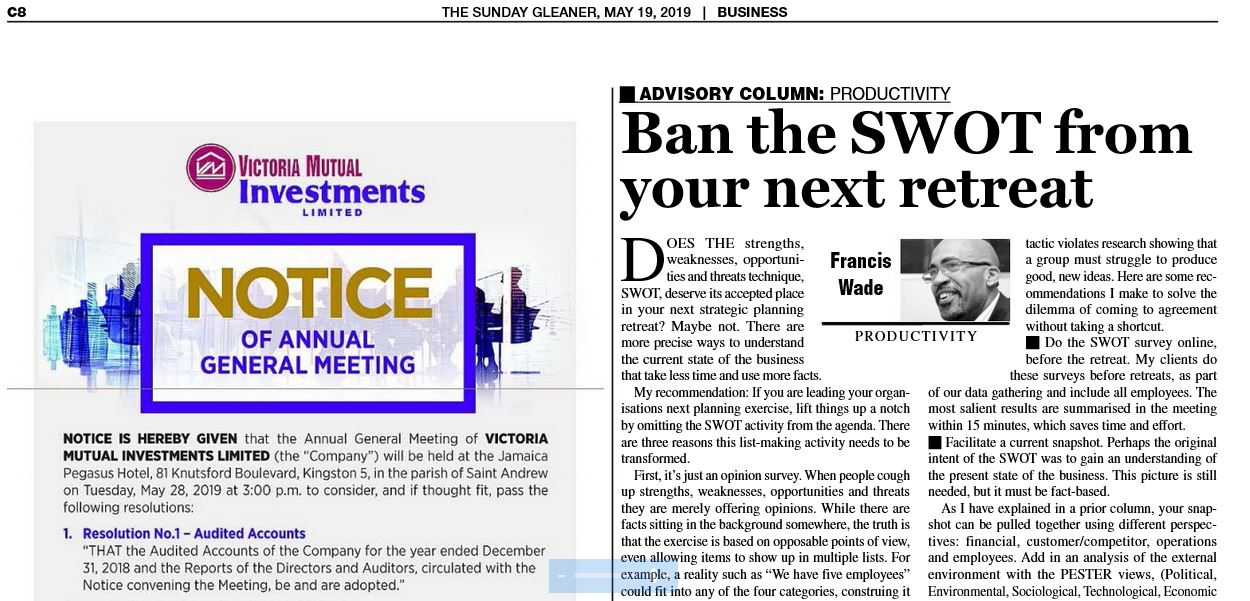Does the Strengths, Weaknesses, Opportunities and Threats (SWOT) technique deserve it‘s accepted place in your next strategic planning retreat? Maybe not. There are more precise ways to understand the current state of the business that take less time and use more facts.
My recommendation: If you are leading your organization‘s next planning exercise, lift things up a notch by omitting the SWOT activity from the agenda. There are three reasons why this list-making activity needs to be transformed.
1. It’s just an opinion survey
When people cough up strengths, weaknesses, opportunities and threats they are merely offering opinions. While there are facts sitting in the background somewhere, the truth is that the exercise is based on opposable points of view, even allowing items to show up in multiple lists. For example, a reality such as “We have five employees” could fit into any of the four categories, construing it as either a “pro” or a “con”.
Given the fact that anyone can have an opinion about anything, merely accumulating these arbitrary points of view is a low-quality exercise. Discussing and debating them at length only reduces your meeting to a talk-shop.
2. It anchors the team in old thinking
The purpose of a well-designed retreat is to establish a clean break from the past. By contrast, the SWOT activity does the very opposite. Why? It merely asks people to rehash old, familiar lines of thinking. This reinforces the emotional link to whatever former strategy happened to be in place, which in turn, makes it harder to create a fresh one.
For example, imagine what happens when the team lists the fact that having five employees is a weakness. Now, it’s difficult to see it as a strength, which it may be in the context of a fast-changing industry. Stating the old concept as the solid truth only stands in the way of realizing a new paradigm.
3. It takes too much time
As the designer of the retreat, you are probably painfully aware that time is a scarce commodity. A SWOT survey gets people talking, but it requires several hours of precious space to collect the group’s point of view, collate and present it. This time could be better spent doing deeper dives into hard data.
Given these three shortcomings (which many executives already quietly realize) why does the exercise continue to be so popular? As a retreat organizer, you may have the answer: because it‘s easy.
Not only is a choice to do the activity never challenged, those who participate are unlikely to challenge each other during the exercise. Unfortunately, this avoidance tactic violates research showing that a group must struggle to produce good, new ideas. Here are some recommendations I make to solve the dilemma of coming to agreement without taking a shortcut.
1. Do the SWOT Survey Online, Before the Retreat
My clients do these surveys before retreats, as part of our data gathering and include all employees. The most salient results are summarized in the meeting within 15 minutes, which saves time and effort.
2. Facilitate a Current Snapshot
Perhaps the original intent of the SWOT was to gain an understanding of the present state of the business. This picture is still needed, but it must be fact-based.
As I have explained in a prior column, your snapshot can be pulled together using different perspectives: financial, customer/competitor, operations and employees. Add in an analysis of the external environment with the PESTER views, (Political, Environmental, Sociological, Technological, Economic and Regulatory), taking special note that technology is emerging as the most critical outside factor.
At first glance, this may seem like a dull recitation of boring data. However, the point is to understand (as a team) the story the facts are telling. Inevitably, this will include a robust discussion of various strengths, weaknesses, opportunities and threats but there‘s no need to group them. Instead, let the information do the talking, rather than hasty opinions, and weave the four SWOT themes into the narrative. Invariably, the tale the data tells is nuanced, filled with ups and downs, polarities, discrepancies and paradoxes. Only a team of insiders with a deep appreciation of the organization and their individual speciality can fully pull it together. Certainly, an outside consultant can’t.
Of course, there are companies which attempt to skip the snapshot altogether and jump right into planning the future. Unfortunately, doing so yields pipe dreams with no foundation in reality. It reduces the trust needed to make a risky move.
In summary, it takes a concerted effort to have everyone on the team see the company’s current position from a joined-up point of view. However, it’s more than a team-building activity: It’s also an evaluation of the status quo which is the first step to carving out a transformative strategy. Don’t block a big change which needs to happen with a costly SWOT mistake.
http://jamaica-gleaner.com/article/business/20190519/francis-wade-ban-swot-your-next-retreat
P.S.
Here is some interesting research found a few years after my article was written: SWOT Analysis: It’s Time for a Product Recall

